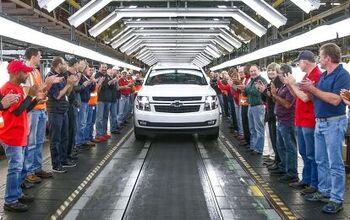GM Offering Buyouts to Salaried U.S. Employees

General Motors is planning to spend an estimated $1.5 billion to buy out a meaningful portion of its salaried workforce in the hopes that the decision will help save the company $2 billion over the next couple of years. While it seems like a very expensive way to save money, CEO Mary Barra clearly feels as though now is the time to strike.
Based on an internal memo intercepted by Automotive News (and later confirmed by GM), Barra said that the scheme is "designed to accelerate attrition in the U.S."
From Automotive News:
"This voluntary program offers eligible employees an opportunity to make a career change or retire earlier. We are offering three packages based on level and service to the company. Employees are strongly encouraged to consider the program," GM spokesperson Maria Raynal said in an emailed statement. "By permanently bringing down structured costs, we can improve vehicle profitability and remain nimble in an increasingly competitive market."
Employees have until March 24 to consider the offer, and those who accept will leave the company by June 30, GM said.
Nonexecutives who take the deal would receive one month of pay for each year with the company, up to 12 months, along with COBRA health insurance coverage, a prorated performance bonus and outplacement services. Executives are eligible to receive base salary, incentives, COBRA insurance and outplacement services.
With the economy in the dumpster, and poised to get worse, it's starting to look as though plenty of automakers are preparing for tougher times. They've likely milked artificial demand for as long as consumers will tolerate and we've continued to see drivers keeping their vehicles for longer periods while pricing remains out of whack for regular people. Meanwhile, most manufacturers already had plans to induce layoffs once their electrification strategies began to reach maturity.
As electric vehicles have fewer moving parts and often have their batteries assembled in Asia, legacy automakers know they'll need fewer hands working on domestic assembly lines. In fact, that was always part of the plan and helped the industry rationalize some of the heavy development costs pertaining to EVs. But advancements in information gathering and organization have also made management types less relevant. Thanks to the pandemic, automakers now have a very good idea of exactly how many paper pushers they need to keep aboard for things to run smoothly.
General Motors hasn't even been all that secretive about the concept and previously announced that it would be terminating a small number of salaried workers in late February over performance-related issues. That equated to about 500 jobs and was allegedly not part of the company’s official plan to reduce costs by $2 billion over the next two years – even though it technically serves the cause.
"To deliver on our commitments and win in this industry, we must have a winning team and hold ourselves accountable for performing at a high level; by focusing on our efficiency, we are preparing for a more competitive environment," GM spokesman David Barnas said at the time. "Today's action follows our most recent performance calibration and supports managing the attrition curve as part of our overall structural costs reduction effort."
But GM is hardly alone in thinking about how to maximize its financial efficiency. That’s been the status quo for the entire industry since 2020, with prospective job cuts being an important part of the overarching plan. Before that, manufacturers were considering how to leverage new revenue streams made available by ubiquitous electrification and vehicle connectivity. And, if we go back even further, domestic automakers were culling smaller, less-profitable models from their lineups to maximize per-vehicle profitability.
Based on this week’s regulatory filing with the Securities and Exchange Commission (SEC), General Motors’ latest plan involves up to $1.5 billion in pretax employee separation costs. However, the final amount will be determined by how many employees take the buyout, with the company estimating that the brunt of its expenses will be incurred through the first half of 2023. It’s worth noting that these cuts will also come before GM has to renegotiate contracts with the Detroit-based UAW and Canada’s Unifor this fall.
GM did not say how many employees it would like to see accepting voluntary separation offers. However, Barra mentioned in Thursday's memo that “taking this step now will help avoid the potential for involuntary actions.”
In addition to reducing its headcount inside the United States, GM is also reportedly looking into further reducing vehicle complexity, increasing the sharing of subsystems between the internal combustion engine and EV programs, investing in “growth initiatives,” and cutting discretionary spending wherever possible to save money.
[Image: Linda Parton/Shutterstock]
Become a TTAC insider. Get the latest news, features, TTAC takes, and everything else that gets to the truth about cars first by subscribing to our newsletter.

A staunch consumer advocate tracking industry trends and regulation. Before joining TTAC, Matt spent a decade working for marketing and research firms based in NYC. Clients included several of the world’s largest automakers, global tire brands, and aftermarket part suppliers. Dissatisfied with the corporate world and resentful of having to wear suits everyday, he pivoted to writing about cars. Since then, that man has become an ardent supporter of the right-to-repair movement, been interviewed on the auto industry by national radio broadcasts, driven more rental cars than anyone ever should, participated in amateur rallying events, and received the requisite minimum training as sanctioned by the SCCA. Handy with a wrench, Matt grew up surrounded by Detroit auto workers and managed to get a pizza delivery job before he was legally eligible. He later found himself driving box trucks through Manhattan, guaranteeing future sympathy for actual truckers. He continues to conduct research pertaining to the automotive sector as an independent contractor and has since moved back to his native Michigan, closer to where the cars are born. A contrarian, Matt claims to prefer understeer — stating that front and all-wheel drive vehicles cater best to his driving style.
More by Matt Posky
Latest Car Reviews
Read moreLatest Product Reviews
Read moreRecent Comments
- Lou_BC Well, I'd be impressed if this was in a ZR2. LOL
- Lou_BC This is my shocked face 😲 Hope formatting doesn't fook this up LOL
- Lou_BC Junior? Would that be a Beta Romeo?
- Lou_BC Gotta fix that formatting problem. What a pile of bullsh!t. Are longer posts costing TTAC money? FOOK
- Lou_BC 1.Honda: 6,334,825 vehicles potentially affected2.Ford: 6,152,6143.Kia America: 3,110,4474.Chrysler: 2,732,3985.General Motors: 2,021,0336.Nissan North America: 1,804,4437.Mercedes-Benz USA: 478,1738.Volkswagen Group of America: 453,7639.BMW of North America: 340,24910.Daimler Trucks North America: 261,959


































Comments
Join the conversation
how's that stock price working for 'ya?
www.generalwatch.com
If Barra left GM today its stock price would fly off the charts. GM was in better shape a decade ago. Under Barra it has been a disheartening time for GM fans. The sales people at my local Chevrolet dealer look glum all the time. Barra has demoralized the entire company. The false distortion field around Barra will eventually break, and we will all see the profound damage done to the company.